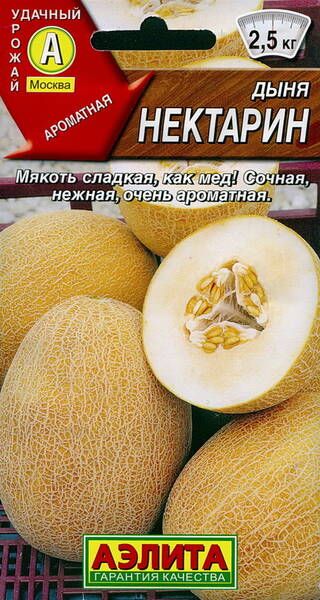Your shopping cart is empty!
Melon "Nektarin"
Melon "Nectarine".
Mid-season variety (95 days from germination to the beginning of ripening). The fruits are oval with a thin net, orange, weighing up to 2.5 kg.
The pulp is white-cream, juicy, very sweet and aromatic. The variety is resistant to low temperatures and other unfavorable conditions.
1,0 g = 25-40 seeds.
Agricultural technology.
Melon is grown in open ground and greenhouses, on light air- and water-permeable soils.
Before sowing, the seeds are treated in a solution of potassium permanganate, then washed with clean water.
Sowing approximately in May, when the soil warms up to a depth of 8-10 cm to +15+16°C. Planting pattern 140x50 cm. In greenhouses 70x40 cm, using trellises (fruits can be hung in nets).
In the northern regions, the seedling method of cultivation is used. In this case, the seedlings are planted after the last spring frosts at the age of 3-4 true leaves.
As they grow, the plants form into one stem, removing the side shoots and leaving 2-3 ovaries on it (the rest are removed).
Further care consists of moderate watering, loosening, fertilizing and sprinkling of vines to protect them from being overturned by the wind.
Mid-season variety (95 days from germination to the beginning of ripening). The fruits are oval with a thin net, orange, weighing up to 2.5 kg.
The pulp is white-cream, juicy, very sweet and aromatic. The variety is resistant to low temperatures and other unfavorable conditions.
1,0 g = 25-40 seeds.
Agricultural technology.
Melon is grown in open ground and greenhouses, on light air- and water-permeable soils.
Before sowing, the seeds are treated in a solution of potassium permanganate, then washed with clean water.
Sowing approximately in May, when the soil warms up to a depth of 8-10 cm to +15+16°C. Planting pattern 140x50 cm. In greenhouses 70x40 cm, using trellises (fruits can be hung in nets).
In the northern regions, the seedling method of cultivation is used. In this case, the seedlings are planted after the last spring frosts at the age of 3-4 true leaves.
As they grow, the plants form into one stem, removing the side shoots and leaving 2-3 ovaries on it (the rest are removed).
Further care consists of moderate watering, loosening, fertilizing and sprinkling of vines to protect them from being overturned by the wind.















